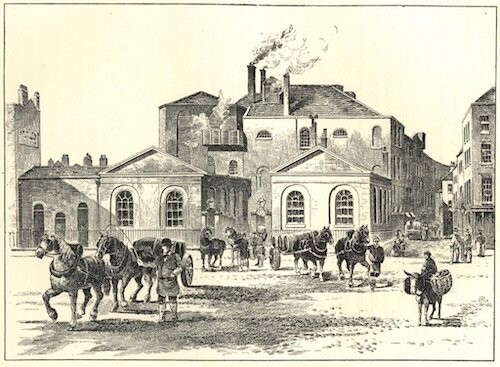The London Beer Flood: The Alcoholic 'Act Of God'

Without any context, a massive beer flood sounds almost whimsical, like an Oktoberfest dream. In reality, the London Beer Flood of 1814 was a deadly nightmare, similar to how the famous 1919 Great Molasses Flood in Boston made molasses look like an unstoppable force.
The epicenter of the alcoholic disaster was the Horse Shoe Brewery owned by Meux & Co. It was located in St Giles, a low-income neighborhood in London, and it was known for its porter. By all accounts, it was a prolific brewery and one of the most successful producers of dark beer in the country.

That was until the fateful day of October 17, 1814. At the Horse Shoe Brewery, porter was fermented in massive 22-foot-tall vats held together by 700-pound iron hoops. On the day of the flood, one of the hoops fell off a vat. This sounds concerning, but it was evidently a fairly common thing and was no cause for immediate alarm for Horse Shoe employees. Around 5:30 p.m., though, the vat violently burst open.
The force of the explosion, caused by the pressure inside the vat, was enough to also open the other vats in the brewery. It even broke through the brick wall of the brewery, releasing hundreds of thousands of gallons of liquid into the streets of London. The massive flood of porter and whatever debris was swept up along the way caused two houses to collapse and left at least eight dead.
Now, this all sounds like a tragedy that the brewery could have done something to prevent. In the end, though, the Horse Shoe Brewery got out of the situation with no real legal punishment. An investigation into the disaster concluded that what happened was an “Act of God,” which meant that the company didn’t have to pay anything. Instead, the brewery actually received waivers from the government, which helped offset the costs of the lost beer and kept them in business.
To end things on a slightly happier note, though, the disaster at the Horse Shoe Brewery was the start of a transition away from wooden vats. Sturdier tanks with concrete were used instead, and these were less likely to explode like the one in London did. Oh, and the Horse Shoe Brewery did close down a century later in 1921, so that’s some consolation.
Top Image: Internet Archive Book Images/Wiki Commons





